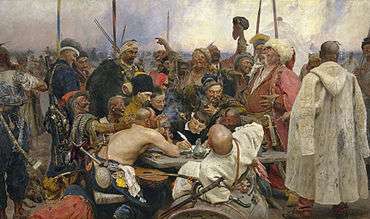Khokhol

Khokhol (Ukrainian: хохол or оселедець, Polish: chochoł or osełedec, Russian: хохо́л) is the stereotypical Ukrainian cossack style of haircut that features a long lock of hair left on the otherwise completely shaved head, commonly sprouting from the top or the front of an otherwise closely shaven head. It is commonly used as a pejorative term for ethnic Ukrainians.[1]
Colloquialism
Russians commonly use the word khokhol as an ethnic slur for Ukrainians, as it was a common haircut of Cossacks. The term is frequently derogatory or condescending, an equivalent of the Ukrainian term katsap and Polish kacap for Russians.[2]
Historically, Ukrainians have used the term khokhol amongst themselves as a form of ethnic self-identification, in order to visibly separate themselves from Russians.[3]
Ukrainian culture
The Ukrainian name for this type of haircut is oseledets (Ukrainian: оселедець, literally "herring") or chub (Ukrainian: чуб, meaning "crest"). There are several Ukrainian surnames derived from this word. In the Cossacks times the haircut carried an honorary meaning identifying one as being a true Cossack. That tradition is depicted in various motion pictures such as Propala Hramota that is based on works of Nikolai Gogol.
The khokhol/oseledets is a standard feature in the stereotypical image of a Ukrainian Cossack.
See also
References
- ↑ Laitin, David D. (1998). Identity in Formation: The Russian-speaking Populations in the Near Abroad. Cornell University Press. p. 175. ISBN 9780801484957.
- ↑ Thompson, Ewa M. (1991). The Search for Self-Definition in Russian Literature. John Benjamins Publishing Company. p. 22. ISBN 978-90-272-7759-6. Retrieved 10 October 2016.
- ↑ Plokhy, Serhii (2008). Ukraine and Russia. Toronto: University of Toronto Press. pp. 139–141.